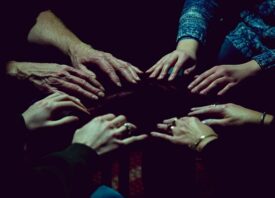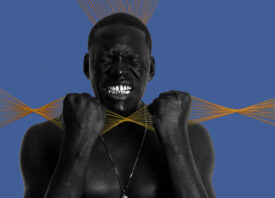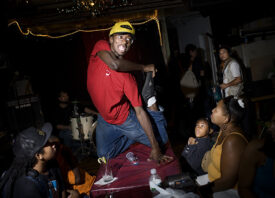Search this site
Photos Show Strange and Intoxicating Vodou Rituals in Brooklyn
Vodou is a religion deeply embedded in Haitian culture, practiced in Haiti and the Haitian diaspora, but thanks to Western culture ‘voodoo’ is repeatedly misunderstood and spurned as some evil religion in pact with the devil. Brooklyn-based photographer Shannon Taggart – whose work centers on ritual and spirituality – set out to explore for herself modern day Vodou ceremonies. In these fascinating black-and-white images taken in a basement temple in Brooklyn, we witness strange, intoxicating scenes as priests and laymen whirl wide-eyed under the spell of the Vodou gods. The immediacy of the action and the intimacy Taggart has achieved through her images draws us in, making us feel almost as if we were present in the basement with her. The result of Taggart’s careful documentation reveals what the heavily stigmatized religion of Haitian Vodou is like, without the prejudice.
We spoke with the photographer to find out more about this project.
What first attracted you to Haitian Vodou?
“I became fascinated with Haitian Vodou after discovering the work of Maya Deren. I soon wanted to witness Vodou ritual for myself, and see how it differed from other religions that also engage a ‘spirit world’, such as Spiritualism, which I have photographed extensively. I moved to Brooklyn in 2005 and I became aware that there was a Haitian community in my area, but it was difficult to make a connection. In 2008, I met R.A. Waldron, a Houngan (Vodou priest), who I am so thankful to for introducing me to his mentor, Mambo Rose Marie Pierre, a third generation priestess from Haiti. Because of Mambo Rose Marie’s generosity, I was finally able to witness and document authentic Haitian Vodou.”

Why is Vodou so misunderstood, and what is the reality that you experienced in New York?
“There are a variety of reasons why Vodou is often misrepresented. My experiences photographing Vodou gave me some insight into why certain practices are misunderstood. For example, machetes, whips, knives, and rope are commonly used in Vodou ritual. These objects, which seem frightening, actually relate to the history of Haitian oppression. Their usage is an effort to take back their symbolic power; much like Christianity did with the cross. Animal sacrifice can also be viewed negatively within our culture, which is now far removed from the realities of farm life. When animals are killed in a ceremony, it is done humanely, and the animals are then used as food. The food made from a sacrificed animal serves as an act of thanks to the Loa (gods or spirits) and as a blessing to those who eat it. Historically, the immediate consumption of animals after a ritual served the additional purpose of ensuring the meat was distributed fresh, and that as many people as possible could share in the eating.”

Can you briefly describe for us what takes place during these ceremonies?
“An elaborate altar is built, with a variety of offerings, and a vever symbol is written on the floor, in cornmeal. Both act as the initial invitation for specific Loa (gods or spirits) to come to the ceremony. Devotional songs are sung, the first being to Legba, the Loa of the crossroads, who controls the entryway to the metaphysical world. Dancing begins, and drums are beaten to a specific rhythm for the Loa who is being called upon. When the Loa appears, it is through the act of possession. The analogy used for possession is as if one’s body is being mounted like a horse, with the Loa as the rider. One cannot be man and god at once, so the individual surrenders their ego to the experience. A temporary amnesia is said to take place, and the events that occur remain a mystery to those possessed.”

Your images reveal a lot visually about the energy and excitement of the ceremonies, but how would you describe the scenes of possession that you witnessed yourself? Were there any points where you felt uncomfortable?
“The temple space is always energized. It is never frightening, but it can be very intense. The feeling of the ceremony can range from light and joyful to dead serious and incredibly frantic. Whatever the tone, there is always a high level of suspense and drama in the air.”

You mention the experience of possession has a temporary amnesic effect on the individual – have the people you photographed seen your images and how did they respond?
“Mambo Rose Marie is always surprised, and sometimes shocked, to see my documentation of what has taken place while she was possessed. She will look at me and say, ‘Really? I did this?’
You can view more images from Basement Vodou here.

All images © Shannon Taggart





